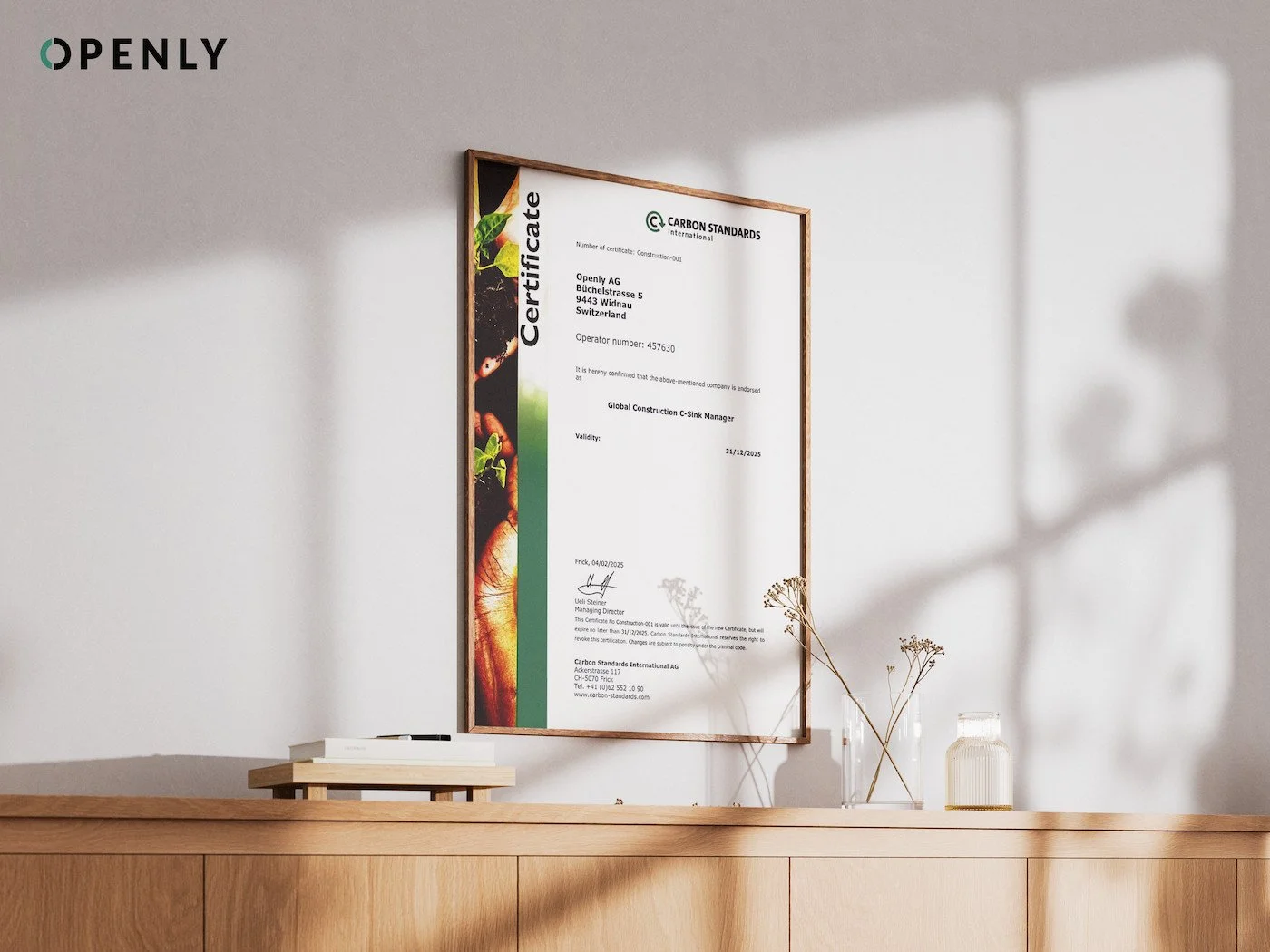Openly launches CO2 certificates for buildings made from biogenic building materials - with partner myclimate
We are pleased to inform you about the successful launch of CO2 certificates for buildings made from biogenic building materials by Openly. This innovative offer makes it possible for the first time to have the carbon sink of buildings made from biogenic building materials certified.
The CO2 certificates now available are based on the Global Construction C-Sink Standard and are certified in accordance with the EU Carbon Removal Certification Framework (CRCF). This provides you with credible proof of your CO2 removals and allows you to integrate them into your carbon management strategy in a targeted manner.
The advantages at a glance:
Integration of biogenic building materials as a valuable component in sustainable construction
Additional funding for investors/builders to finance biogenic building materials
Use of internationally recognized standards for maximum transparency and trust
Sustainable support for your company's climate goals through certified CO2 removals (purchase or insetting with your construction activity)
The services of OPENLY AG:
Certification of installed C sinks in the building with completion date from 1.1.2024
Preparation of CO2 balances according to SIA390 / DGNB
Component proposals for radically CO2-reduced and CO2-storing components
We have summarized the most important topics relating to the launch in a question and answer overview (see below) and a media release.
Further information can be found on the websites below. We will be happy to provide you with individual advice.
Contact us on +41 78 300 36 82.
openly.systems CO2 certificates
myclimate.org carbon offset projects
global-c-registry.org Projects
carbon-standards.com Global Construction C-Sink Standard
Together, we are shaping the future of construction - sustainably, transparently and effectively.
Questions & answers on the most important launch topics
What is the core concept behind the launch of CO2 certificates for biogenic buildings and the importance of the partnership with myclimate?
The basic principle is to recognize and certify buildings as functional carbon sinks. When biogenic materials such as wood are used in construction, they sequester CO2 from the atmosphere throughout the life of the building. The aim is to quantify this stored CO2 and convert it into verifiable CO2 certificates. Openly has found its first supporter and re-seller in the climate foundation myclimate, which has already gained a lot of experience in the voluntary carbon market. Together, we want to provide a new mechanism for financing sustainable construction projects via the voluntary carbon market.
The certification is based on the "Global Construction C-Sink Standard". What does this standard entail and how does it ensure the credibility and accuracy of the carbon sequestration data?
The Global Construction C-Sink Standard (Carbon Standards International and Ithaka Institute) provides a rigorous, transparent methodology for calculating the net amount of CO2 stored in a building. It sets out clear criteria for what constitutes a carbon sink in the built environment. The process includes a detailed life cycle assessment, starting with the amount of CO2 absorbed by the biomass during its growth phase. From this we subtract the emissions generated during the harvesting, processing, transportation and construction phases. The resulting net value corresponds to the amount of CO2 actually sequestered. The standard's strict rules and verification procedures ensure that each certificate corresponds to a quantifiable and permanent removal of CO2 from the atmosphere, ensuring the credibility and integrity of the scheme. Openly is already accredited as a C-Sink manager and takes care of certification for building owners. The new Openly brand milton.earth trades in these CO2 certificates. The aim is for buyers to be able to purchase CO2 certificates that correspond to their net zero strategy. The innovative aspect of the CO2 certificates created: the building is the C-sink. And all certificates and the projects behind them can be viewed transparently in the Global C-Sink Registry.
What role do biogenic building materials play in this certification and what are the key benefits for construction companies and property owners who take this approach?
Materials such as wood, hemp or straw come from living organisms and naturally contain carbon that has been absorbed from the atmosphere. By integrating these materials into durable structures, we effectively sequester this carbon. For construction companies and developers, the main benefit is the creation of a new revenue stream. The sale of carbon credits generated from their buildings provides a direct financial incentive to prioritize sustainable materials. For real estate owners, a certified building is a tangible commitment to climate protection that increases its value and appeal in a market that is increasingly focused on environmental, social and governance (ESG) criteria. It transforms a building from a source of emissions into a quantifiable climate solution.
How does the certification of buildings as carbon sinks contribute to broader corporate sustainability goals and global efforts to achieve net zero emissions?
This certification offers companies a clear way to make a contribution to climate protection. Companies in the construction industry can use it to directly reduce their operational carbon footprint. For other companies looking to achieve their sustainability goals, the purchase of these certificates supports the large-scale removal of CO2 through the development of CO2 storage infrastructure. This is directly in line with the concept of net zero emissions, which requires not only the reduction of emissions, but also the active, permanent removal of greenhouse gases from the atmosphere. By investing in biogenic construction, companies are supporting scalable and permanent carbon removal technology, going beyond traditional offsetting to fund additional, verifiable climate impact.
What does the future of sustainable construction look like and how will innovations such as the Construction C-Sink Standard influence the development of the industry?
The future of construction must involve a systemic shift from being one of the largest sources of global emissions to being an important part of the solution. We expect a paradigm where the carbon footprint of a building plays an important role in the initial design phase, but also the "ability" of a building to store CO2 for decades. Standards such as the Global Construction C-Sink will be instrumental in driving this change. They provide the necessary framework to measure, verify and monetize the climate benefits of sustainable building practices. This will accelerate the adoption of biogenic materials and innovative building techniques. Ultimately, we envision an industry where every new building has the potential to be a net carbon sink, making a positive contribution to the planet's carbon footprint and playing a critical role in the development of climate resilient cities.


